Kyanite
A mineral used to make porcelain, as an abrasive, and occasionally as a gemstone
Article by: Hobart M. King, PhD, RPG
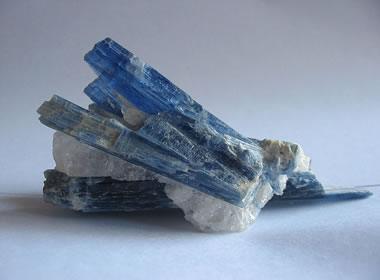
Blue kyanite crystals: A very common habit of kyanite is blue bladed crystals. Image by Aelwyn, displayed here under a Creative Commons license.
What is Kyanite?
Kyanite is a mineral found mainly in metamorphic rocks. It most often forms from the high-pressure alteration of clay minerals during the metamorphism of sedimentary rocks. It is found in the schists and gneisses of regionally metamorphosed areas and less often in quartzite or eclogite.
Kyanite's typical habit is a bladed crystal, although it sometimes occurs as radiating masses of crystals. Kyanite is often associated with other metamorphic minerals such as garnet, staurolite, and corundum.
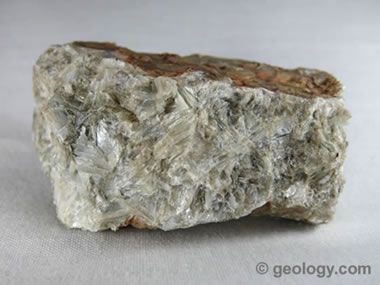
Radiating kyanite: Sometimes kyanite occurs as radiating masses of crystals such as this specimen from Petaca, New Mexico. Specimen is about 4 inches (ten centimeters) across.
Kyanite's Unusual Hardness
Kyanite specimens have a variable hardness. The long crystals have a Mohs hardness of about 4.5 to 5 if tested parallel to the length of a crystal, and a hardness of 6.5 to 7 if tested across the short dimension of a crystal. The mineral was once commonly called "disthene" which means "two strengths."
Physical Properties of Kyanite |
|
| Chemical Classification | Silicate |
| Color | Blue, white, gray, green, colorless |
| Streak | White, colorless |
| Luster | Vitreous, pearly |
| Diaphaneity | Transparent to translucent |
| Cleavage | Perfect in two directions, faces sometimes striated |
| Mohs Hardness | Kyanite often occurs in long, bladed crystals. These have a hardness of 4.5 to 5 along the length of the crystals and 6.5 to 7 across the width of the crystals. |
| Specific Gravity | 3.5 to 3.7 |
| Diagnostic Properties | Color, cleavage, bladed crystals |
| Chemical Composition | Al2SiO5 |
| Crystal System | Triclinic |
| Uses | Ceramics, gemstones |
Polymorphs of Al2SiO5
Three minerals have a chemical composition of Al2SiO5. These are kyanite, andalusite, and sillimanite. Kyanite is the high-pressure polymorph, sillimanite forms at high temperature, and andalusite is the low-pressure polymorph.

Kyanite porcelain sink: Kyanite is used in the porcelain of sanitary fixtures. Image copyright iStockphoto / Carl Kelliher.
Many Industrial Uses of Kyanite
Kyanite is used to manufacture a wide range of products. An important use is in the manufacture of refractory products such as the bricks, mortars, and kiln furniture used in high-temperature furnaces. For foundries, the molds that are used for casting high-temperature metals are often made with kyanite.
Kyanite is also in products used in the automotive and railroad industries where heat resistance is important. Mullite, a form of calcined kyanite, is used to make brake shoes and clutch facings.

Kyanite spark plug: The porcelain insulator on this spark plug was made with kyanite. Image copyright iStockphoto / Juergen Barry.
Use in High-Refractory-Strength Porcelain
Kyanite has properties that make it exceptionally well suited for the manufacture of a high-refractory-strength porcelain - a porcelain that holds its strength at very high temperatures. A familiar use of this type of porcelain is the white porcelain insulator on a spark plug.
Kyanite is also used in some of the more common forms of porcelain, such as those used to make dentures, sinks, and bathroom fixtures.

Kyanite cutting wheel: Kyanite is used as a heat-resistant binding medium in cutting tools and grinding wheels. Image copyright iStockphoto / Ron Sumners.
Use in Abrasive Products
Kyanite's heat resistance and hardness make it an excellent material for use in the manufacture of grinding wheels and cutting wheels. It is not used as the primary abrasive; instead, it is used as part of the binding agent that holds the abrasive particles together in the shape of a wheel.
Expansion of Kyanite When Heated
Kyanite, unlike most other minerals, can expand significantly when heated. Depending upon particle size, temperatures, and heating conditions, kyanite can expand to up to twice its original volume when heated. This expansion is predictable. In the manufacture of certain refractory products, specific amounts of kyanite are added to the raw material (which shrinks during heating) to maintain volume in the finished product.

Kyanite cabochons: Kyanite is often cut "en cabochon" or as a faceted gemstone. Shown above are kyanite cabochons ranging in color from clear to blue to green and black.
Kyanite Use as a Gemstone
Kyanite is a gemstone that you will rarely encounter in the typical jewelry store. Most people have not heard of kyanite, as it is infrequently used in jewelry. It is an "exotic" gem. Perhaps that is what makes it so interesting?
If you are interested in kyanite as a gemstone or in jewelry, the best place to find it is in artisan jewelry stores or in jewelry stores that are associated with a mineral dealer. The people who own these businesses are likely to be interested in kyanite and incorporate it into their product line.
High-quality and nicely colored kyanite can be cut into attractive and desirable cabochons and faceted stones. These are often used in rings, earrings, pendants, and other jewelry. Kyanite is also used to make beads. These beads often have a flat geometry because the mineral typically occurs in thin blades.
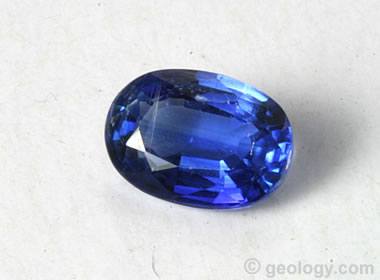
Faceted kyanite: A faceted kyanite gemstone with a beautiful deep blue color.
Kyanite Gemstones are Challenging to Cut
Kyanite is a challenging mineral to cut because it has two distinctly different hardnesses. Kyanite crystals are typically long, narrow blades. They have a hardness of about 4.5 parallel to their length but a hardness of 6.5 to 7.0 across the width of the blade. Skilled cutters are needed to work these stones.

Green kyanite crystals: Green kyanite blades in quartzite from Avery County, North Carolina. Specimen is about four inches (ten centimeters) across.
Blue Kyanite - Green Kyanite
Most gemstone-quality kyanite is blue in color. However, kyanite can be clear, green, black, and rarely purple. Some kyanite gemstones are pleochroic (appear to be different colors when viewed from different directions).
Blue kyanite stones can be found in a continuous color range between clear and dark blue. The most popular kyanite gemstones are transparent with a deep sapphire-blue color. Some deep blue stones are shown in the photos on this page. Transparent blue kyanite with a lower color intensity might look like blue topaz or blue aquamarine.

The best way to learn about minerals is to study with a collection of small specimens that you can handle, examine, and observe their properties. Inexpensive mineral collections are available in the Geology.com Store. Image copyright iStockphoto / Anna Usova.
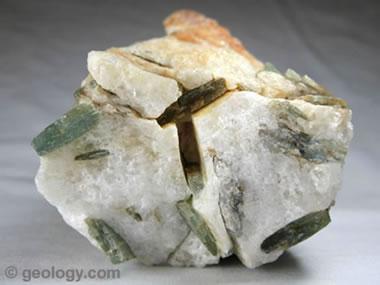
Green kyanite crystals: Green bladed kyanite (same specimen as above) - looking down the long axis of the blades. Specimen is about 4 inches (10 centimeters) across.
| More Minerals |
 |
Copper |
 |
Gifts That Rock |
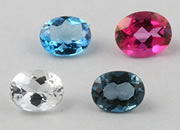 |
Topaz |
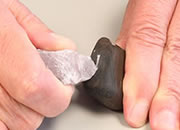 |
Mohs Hardness Scale |
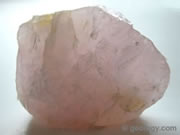 |
Quartz |
 |
Tourmaline |
 |
Rhodochrosite |
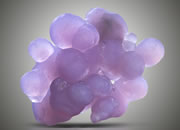 |
Grape Agate |

Find Other Topics on Geology.com:

|

| ||

|

| ||

|

| ||

|

|
